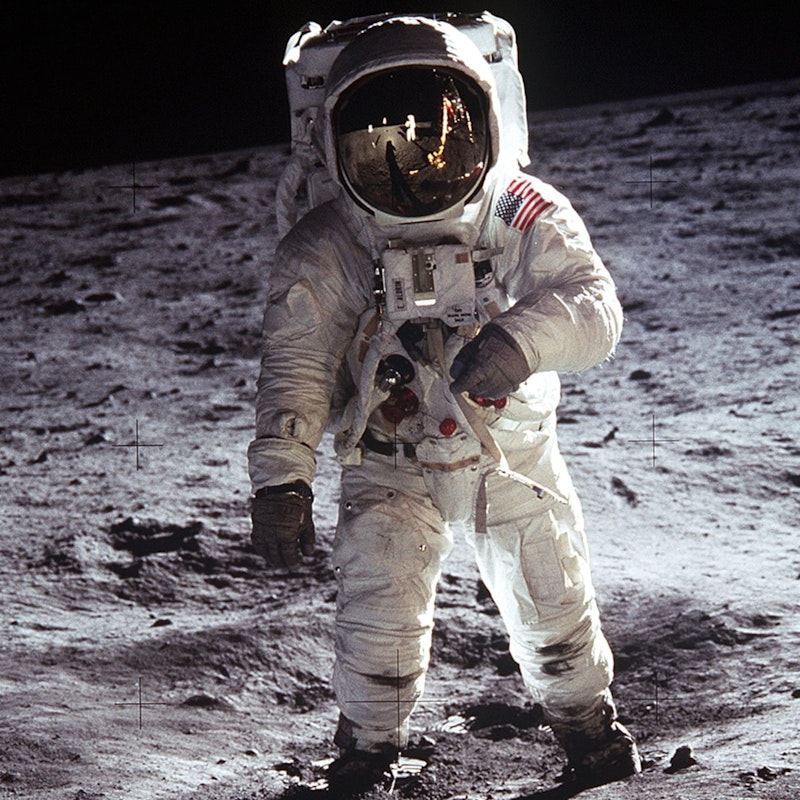I’ve spoken to three of the 12 men who walked on the moon and one of the other 12 who flew around it. On my first day at the Internet start-up Space.com in 2000, I was shown to an empty desk, but then someone said it was “Buzz’s desk.” I thought that was a joke, but a moment later Buzz Aldrin walked in and shook my hand. He was visiting for the day.
A few months later, I interviewed Eugene Cernan by phone about his book The Last Man on the Moon, and also met Gen. Tom Stafford when he came by the office; Stafford and Cernan had taken the lunar module close to the moon for Apollo 10, and Cernan went back for Apollo 17.
For Scientific American, I interviewed Harrison Schmitt, who’d also been on Apollo 17, about planned moon missions that never took place. The only scientist yet on the moon, and a former Republican senator, Schmitt had pressed unsuccessfully for a far-side landing and was bummed that the Apollo program got scrapped, rather than making further use of the powerful Saturn V rockets. But he expressed hope that humans would return to the moon and utilize its helium-3 for nuclear-fusion reactors.
The other astronaut I met was Sally Ride, who served as president of Space.com. She was the first American woman in space, and the youngest American in space, traveling in Earth orbit.
Two new books from Princeton University Press provide though-provoking views on space exploration. Back to the Moon: The Next Giant Leap for Humankind, by cosmologist Joseph Silk, notes the moon’s potential for mining and tourism, and makes a persuasive case for lunar astronomy, the deployment of telescopes on the moon. The moon’s low gravity, a sixth of Earth’s, would enable installation of giant radio telescopes. Located on the far side, in a signal-free “quiet zone,” these instruments would probe the “dark ages,” before the first stars were born, and advance the search for extraterrestrial intelligence. Other telescopes would benefit from the moon’s lack of atmosphere to capture images of exoplanets around other stars.
Such science, Silk writes, could be subsidized by commercial development of the moon’s rare minerals, as well as lunar luxury hotels. Recreational activities may include low-gravity golf, pioneered by Alan Shepard in 1971. Negotiations between the U.S. and other space powers will be needed to ensure peaceful division of territories for various purposes. The moon will also serve as a way station for human and robotic travels through the solar system and beyond.
Silk’s vision is appealing, though occasionally veers into transhumanist hubris: “If humans are ever to attain quasi-immortality, the lunar low-gravity environment will play a crucial role in developing the essential medical transplants. We will learn to replace all our vital organs. As computers become ever more powerful, we may replace our brains as well—or at least upgrade their memory contents.” Following philosopher Susan Schneider, I recommend skepticism as to whether uploading your mind would extend “your” life.
A Traveler’s Guide to the Stars, by physicist Les Johnson, is a lucid examination of prospects for interstellar exploration, including robotic missions but also how humans might eventually bridge the vast gaps between the stars. Johnson states his personal ambition: “When future human settlers on an exoplanet write a history book describing how their new world came to be explored and settled, I would like for my technical work to be cited as a footnote.”
Johnson discusses various possibilities for propulsion of interstellar spacecraft. Chemical rockets and nuclear fission have limitations that make them unlikely candidates for getting beyond the solar system. Nuclear fusion is more promising, but still involves traveling centuries to get to the nearest stars, and technical challenges of carrying or acquiring propellant. A spacecraft lofted by hydrogen bombs, as envisioned in the 1960s Project Orion, is another option, but one that would have problematic environmental consequences.
Solar sails may prove a useful technology for interstellar travel, as could antimatter engines. However, revolutionary advances will be needed in any case. Johnson contemplates some ideas discussed in science fiction, such as Star Trek’s warp drive (an engine warping space as a ship moves through it), the Star Wars hyperdrive (the ship leaving ordinary space) or a wormhole as in the movie Contact, but such prospects are speculative at best.
Johnson considers ethical and cultural aspects of interstellar exploration. He argues against objections that it’s a new version of “manifest destiny,” calling instead for a principle, similar to Star Trek’s Prime Directive, to avoid interfering with any alien life. As he notes, a multi-generational space mission will have political as well as technical challenges, including that descendants may not approve, or even remember, the objectives with which the voyage began.
—Kenneth Silber is author of In DeWitt’s Footsteps: Seeing History on the Erie Canal and is on Twitter: @kennethsilber

